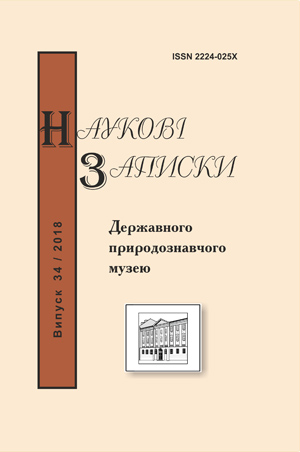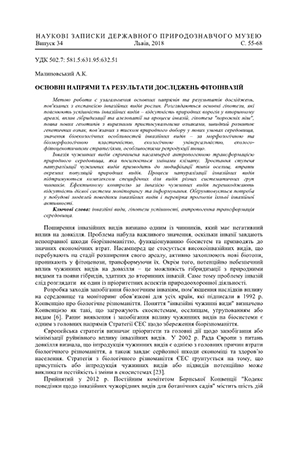Malynovskyі A.К.
Main directions and results of researches of phytoinvasion // Proc. of the State Nat. Hist. Mus. - Lviv, 2018. - P.55-68. DOI: https://doi.org/10.36885/nzdpm.2018.34.55-68 Key words: invasive species, hypothesis of success, anthropogenic transformation of the environment The aim of this work is to generalize the main trends and the research results related to the expansion of invasive plant species. The main hypotheses that explain the success of invasive species are reviewed. The hypotheses are: absence of natural enemies in the secondary area, influence of hybridization and allelopathy on the processes of invasion, the hypothesis of vacant niches, the emergence of new genotypes with expressive adaptive features, the rapid development of genetic traits associated with the pressure of natural selection in new environmental conditions, the importance of bioecological features of invasive species – by morphological and biomorphological plasticity, ecological versatility, ecological-phytocoenic strategies, features of reproduction, etc. Invasion of non-native species is primarily caused by anthropogenic transformation of the natural environment, which is aggravated by climate change. The increasing level of transformation of the environment leads to an increase in the degree of naturalization of non-native species, and as a consequence to modification of types of habitats and to a loss of individual populations of natural species. Processes of naturalization of invasive species are supported by a set of specific various systematic groups of factors. The lack of an effective monitoring system and information tools prevents effective control of invasive non-native species. The necessity to construct models of the behavior of invasive species and to check the predictions of their invasive activity is substantiated.
Main directions and results of researches of phytoinvasion // Proc. of the State Nat. Hist. Mus. - Lviv, 2018. - P.55-68. DOI: https://doi.org/10.36885/nzdpm.2018.34.55-68 Key words: invasive species, hypothesis of success, anthropogenic transformation of the environment The aim of this work is to generalize the main trends and the research results related to the expansion of invasive plant species. The main hypotheses that explain the success of invasive species are reviewed. The hypotheses are: absence of natural enemies in the secondary area, influence of hybridization and allelopathy on the processes of invasion, the hypothesis of vacant niches, the emergence of new genotypes with expressive adaptive features, the rapid development of genetic traits associated with the pressure of natural selection in new environmental conditions, the importance of bioecological features of invasive species – by morphological and biomorphological plasticity, ecological versatility, ecological-phytocoenic strategies, features of reproduction, etc. Invasion of non-native species is primarily caused by anthropogenic transformation of the natural environment, which is aggravated by climate change. The increasing level of transformation of the environment leads to an increase in the degree of naturalization of non-native species, and as a consequence to modification of types of habitats and to a loss of individual populations of natural species. Processes of naturalization of invasive species are supported by a set of specific various systematic groups of factors. The lack of an effective monitoring system and information tools prevents effective control of invasive non-native species. The necessity to construct models of the behavior of invasive species and to check the predictions of their invasive activity is substantiated.
References
- Abduloieva O.S., Karpenko N.I. Obgruntuvannia kryteriiv invaziinoho potentsialu chuzhynnykh vydiv roslyn v Ukraini // Chernomorsk. bot. zh. – 2012. – T. 8, № 3: – S. 252-256. [In Ukrainian]
- Akatov V.V., Akatova T.V. Vidovoi pul, vidovoe bogatstvo, effekt kompensatcii plotnostiu i invazibelnost rastitelnykh soobshchestv // Ross. zhurn. biol. invazii. – 2012. – № 3. – S. 2-19. [In Russian]
- Vinogradova Iu.K. Eksperimentalnoe izuchenie rastitelnykh invazii (na primere roda Bidens) // Problemy izucheniia adventivnoi i sinantropnoi flory v regionakh SNG. – M.: Botan. sad MGU, 2003. – S. 31 -33. [In Russian] Vinogradova Iu.K., Maiorov S.R., Khorun L.V. Chernaia kniga flory Srednei Rossii (Chuzherodnye vidy rastenii v ekosistemakh Srednei Rossii). – M.: GEOS, 2009. – 494 s. [In Russian]
- Eremenko Iu.A. Allelopaticheskaia aktivnost invazionnykh drevesnykh vidov // Ross. zhurn. biol. invazii. – 2014. – № 2. – S. 33-39. [In Russian]
- Konventcіia pro bіologіchne rіznomanіttia. – K.: [b. v.], 1996. – 15 s.
- Krivosheina M.G. Nasekomye-vrediteli borshchevika Sosnovskogo v Moskovskom regione i perspektivy ikh ispolzovaniia v biologicheskoi borbe // Biull. MOIP. Otdelenie Biologiia. – 2009. – № 114 (1). – S. 26-29. [In Russian]
- Kuklina A.G. Vozmozhnye puti proiskhozhdeniia nekotorykh vidov irgi // Netraditcionnye i redkie rasteniia, prirodnye soedineniia i perspektivy ikh ispolzovaniia: VII Mezhdunar. simpoz., Belgorod, 24-27 maia., 2006. – S. 16-19. [In Russian]
- Makhrov A.A., Karabanov D.P., Kodukhova Iu.V. Geneticheskie metody borby s chuzherodnymi vidami // Ross. zhurn. biol. invazii. – 2014. – № 2. – S. 110-126. [In Russian]
- Mosiakin A.S. Suchasni metody biolohichnoho kontroliu (biolohichnoho rehuliuvannia) aktyvnosti invaziinykh roslyn: pryklady y perspektyvy zastosuvannia // Nauk. osnovy zberezh. biotych. riznomanitnosti. – 2012. – T. 3(10), № 1. – S. 93-109. [In Ukrainian]
- Protopopova V.V., Mosiakin S.L., Shevera M.V. Fitoinvazii v Ukraini yak zahroza bioriznomanittiu: suchasnyi stan i zavdannia na maibutnie. – K.: In-t botaniky im. M.H. Kholodnoho NAN Ukrainy, 2002. – 32 s. [In Ukrainian]
- Khorun L.V. Problemy invazionnoi ekologii v zarubezhnoi nauchnoi literature // Vest. Udmurt. un-ta. Biologiia. Nauki o zemle. – 2014. – Vyp. 3. – S. 64-77. [In Russian]
- Chorna H.A. Reproduktyvna biolohiia invaziinykh vydiv vyshchoi flory // Visn. Kharkiv. nats. un- tu im. N.V. Karazina. Ser.: Biolohiia. – 2014. – № 1100, vyp. 20. – S. 377-380. [In Ukrainian]
- Cadenasso M.L., Pickott S.T.A. Effect of edge structure on the flux of species into forest interiors // Conservation Biology. – 2001. – Vol. 15. – P. 91 -97.
- Callaway P.M., Aschchoug E.T. Invasive plant versus their new and old neighbors: a mechanism for exotic invasion // Science. – 2000. – Vol. 290. – P. 521-523.
- Cornell H.V. Species assemblages of cynipid gall wasps are not saturated // Amer. Natur. – 1985. – V. 126. – Р. 565-569.
- Cornell H.V. Unsaturated patterns in species assemblage: the role of regional processes in setting local species richness. Species diversity in ecological communities: historical and geographical perspectives / Eds. Ricklefs R.E., Schluter D. – Chicago: Chicago University Press, 1993. – P. 243-253.
- Crawley M.J. What makes a community invasible? // Colonization, Succession, and Stability (eds A.J. Gray, M.J. Crawley & P.J. Edwards). – Blackwell, Oxford, 1987. – P. 429-453.
- Crawley M.J. Insect herbivores and plant population dynamics // Annual Review of Entomology. – 1989. – № 34. – Р. 531 -564.
- Crawley M.J. Plant-herbivore dynamics // Plant Ecology (ed. M.J. Crawley). – Blackwell Science, Cambridge, Massachusetts, 2002. – Р. 401 -474.
- Ellstrand N.C., Schierenbeck K.A. Hybridization as a stimulus for the evolution of invasiveness in plants? // Proc. Nat. Acad. Sci. USA. – 2000. – Vol. 97. – P. 7043-7050.
- Elton С. The ecology of invasions by animals and plants. – London: Methuen & Co, 1958. – 356 p.
- European Strategy on Invasive Alien Species / Piero Genovesi and Clare Shine Convention on the Conservation of European Wildlife and Habitats (Bern Convention). Council of Europe Publishing F-67075 Strasbourg Codex ISBN 92-871 -5488-0, June 2004 / Nature and environment, No. 137. – [68 p.] [Електронний ресурс]. – Режим доступу: //www.cbd.int/doc/external/cop-09/bern-01 -en.pdf.
- Hierro J.L., Maron J. L., Callaway R.M. A biogeographical approach to plant invasions: the importance of studying exotics in their introduced and native range // J. of Ecology. – 2005. – Vol. 93. – P. 5-15.
- Higgins S.I., Nathan R., Cain M.L. Are long-distance dispersal events in plants usually caused by non-standard means of dispersal? // Ecology. – 2003. – Vol. 84. – P. 1945-1956.
- Lonsdale W.M. Global patterns of plant invasions, and the concept of invisibility // Ecology. – 1999. – Vol. 80. – P. 1522-1536.
- Mack R.N. Biotic invasions: causes, epidemiology, global consequences and control // Ecol. Applications. – 2000. – Vol. 10. – P. 689-710.
- Protopopova V.V., Shevera M.V., Mosyakin S.L. Deliberate and unintentional introduction of invasive weds: A case study of the alien flora of Ukraine [text] // Euphytica. – 2006. – Vol. 148. – P. 17-33.
- Pyšek P., Hulme P.E. Spatio-temporal dynamics of plant invasions: linking pattern to process // Ecoscience. – 2005. – Vol. 12. – P. 302-315.
- Rejmanek M. Invasibility of plant communities // Biological Invasions. A Global Perspective (Eds.: J.A. Drake, H.A. Mooney). – Chichester: John Wiley & Sons, 1989. – P. 369-388.
- Sakai A.K. The population biology of invasive species // Annual Review of Ecology and Systematics. – 2001. – Vol. 32. – P. 305-332.
- Smith M.D., Knapp A.K. Exotic plant species in C4-dominated grassland: invasibility, disturbance, and community structure // Oecologia. – 1999. – 120. – Р. 605-612.
- Thompson J.N. The use of ephemeral plant parts on small host plants: How Depressaria leptotaeniae (Lepidoptera: Oecophoridae) feeds on Lomatium dissectum (Umbelliferae) // Journal of Animal Ecology. – 1983. – 52. – Р. 281 -291.
- Tokhtar V.K., Khomyakov M.T. Symbiotic interaction of alien plant species and lower fungi in Ukraine // 3 Int. Congr. on Symbiosis (Marburg, August, 2000). – P. 219
- Williamson M., Fitter A. The characters of successful invaders // Biological Conservation. – 1996. – Vol. 78. – P. 163-170.
- Williamson M., Pyšek P., Jarošík V., Prach K. On the rates and patterns of spread of alien plants in the Czech Republic, Britain, and Ireland // Ecoscience. – 2005. – Vol. 12. – P. 424- 433.


